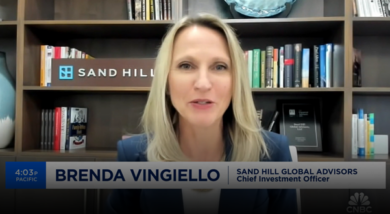Brenda Vingiello, Sand Hill's Chief Investment Officer, joined the Halftime Report to discuss the software space. This content was produced and provided by an unaffiliated

The Recession That Wasn’t
July 21, 2023
The last several years have been full of unexpected surprises, with the most recent one being the lack of a recession given that many economists had been repeatedly predicting that one was surely just six months away. A recession has certainly seemed like it would be an obvious outcome when considering the combined following developments: the Treasury yield curve has been inverted for more than a year, the Federal Reserve has raised interest rates so aggressively since last year that it forced the important housing market into decline, inflation has been stubbornly high, and financial conditions have tightened, forcing many small businesses and commercial property owners to turn to the private lending market for loans even though such borrowing rates are very high. So, what has caused the economy to be so resilient? In our view, the answer lies in a series of favorable circumstances that have contributed to a strong consumer, which has effectively overcome these negative forces.
One enormous lingering benefit that hasn’t received a lot of attention is the favorable refinancing wave that took place in 2020 and 2021. Shortly after the pandemic began, short and long-term interest rates declined to historic lows and many homeowners jumped at that opportunity to take on the project of refinancing their mortgage—a painful yet fruitful use of their time stuck sheltering in place. According to an analysis by the New York Federal Reserve, about 14 million homeowners opted to refinance their home loans during this period. This represented about one-third of all outstanding mortgages at the time and the average annual savings were estimated to be $2,640 a year. Given that the average annual income of homeowners in the U.S. is $86,000, this essentially served as a 3%+ pay raise. In our view, this also explains why most Americans haven’t been impacted by higher rates as they are still enjoying historically low interest rates tied to their largest asset. Some of this may go away in a few years’ time as adjustable-rate mortgages reset. However, more than 80% of homeowners have conventional loans which suggests that these locked-in low rates will benefit homeowners for as long as they own their homes.
During the pandemic, an unusually high number of people dropped out of the workforce for personal reasons, and this caused many to question the reliability of the reported unemployment rate at the time. Furthermore, there was a lot of speculation about whether participation in the workforce would ever return to pre-pandemic levels. With the continuing strength of the job market as well as solid wage growth, participation in the workforce for people in their prime working years (age 25-54) has improved meaningfully and is now higher than it was before the pandemic. This strongly suggests that unemployment is truly historically low, which supports ongoing strength in consumption.
There have been many drivers of a strong employment market and one of them is quite unique to this moment in history. In 2021 and 2022, Congress passed three separate bills: the Infrastructure Investment and Jobs Act (IIJA), Inflation Reduction Act (IRA), and CHIPs and Science Act. These all provided funding and tax incentives for public and private manufacturing construction. Historically, it has taken years for legislation like this to bear any fruit, but that hasn’t been the case this time. Since the beginning of last year, spending on the construction of new factories has more than doubled. Most of this growth has been driven by computers, electronics, and electrical manufacturing. This is a very new focus for such U.S. fiscal stimulus as this type of spending primarily happened overseas during the prior decade. As of April of this year, factory construction made up 10% of total construction in the U.S., almost double what it was over the prior decade. So, even though the Federal Reserve’s actions have been slowing some parts of the economy, others are being directly helped by these fiscal policies. Right now, the only jobs being created by this work are tied to the construction of these manufacturing facilities, but over the next several years, a new resulting wave of manufacturing jobs will be available, and this has the potential to provide a great employment opportunity that has been absent for most of the last decade.
The baby boomer generation had a profound impact on the economy during their younger years given its size and the resulting number of working age adults, as well as the acceptance of women going to college and entering the workforce. As far as size goes, the millennial generation overtook the baby boomers back in 2020, but the baby boomers are still having a significant impact on the economy. This generation is now 59 – 77 years old and has an estimated $75 trillion in net worth at this point. This sizable savings will be available to support ongoing consumption as this generation fully retires. Plus, unlike the working age population, consumption from this group will probably not be tied as much to the health of the current economy which could serve to smooth consumption trends. Furthermore, there is evidence that a larger than usual number of retirements for this cohort occurred during the pandemic itself which helps explain some of the ongoing strength of the consumer over the last few years.
However, despite these positive factors, there are still reasons to be concerned about the impact of higher interest rates. Recent readings of inflation suggest that the Federal Reserve might be just one more small rate increase away from a more permanent pause. Nevertheless, this doesn’t change the dynamic that has evolved within the banking industry. Banks have become increasingly unwilling to extend loans to small businesses and some commercial property owners. Private lenders are more than happy to step in but are charging rates in the double digits. In our view, this will eventually slow down this part of the economy that is responsible for more than an estimated 40% of jobs. If these businesses become so stretched that they begin to eliminate jobs, the broader economy will surely be impacted. But we are not yet seeing signs of this right now.
Striking a balance between being prepared for the here and now while also being mindful of what surprises the future might hold is one of the constant great challenges of investing. Over the last year, we have become much more positive about the prospect of bonds being able to deliver more meaningful returns over the next 3 – 5 years given the significant increase in interest rates that have already occurred in a matter of just 15 months. Recent readings of current inflation suggest that we are not experiencing a repeat of the 1970s, with inflation now much closer to the Federal Reserve’s target. This suggests that it is only a matter of time before interest rates begin to come down from restrictive levels, thus supporting a positive price return from bonds. Furthermore, if the economy were to weaken from current levels, interest rates would most likely decline, resulting in bonds being a source of portfolio ballast. In addition, many parts of the stock market haven’t rebounded as meaningfully as large cap technology stocks have, and we continue to view these other areas as sources of future opportunity and have tactically positioned our clients’ portfolios accordingly. As always, we continue to monitor the economic environment and investment landscape on your behalf.
Articles and Commentary
Information provided in written articles are for informational purposes only and should not be considered investment advice. There is a risk of loss from investments in securities, including the risk of loss of principal. The information contained herein reflects Sand Hill Global Advisors' (“SHGA”) views as of the date of publication. Such views are subject to change at any time without notice due to changes in market or economic conditions and may not necessarily come to pass. SHGA does not provide tax or legal advice. To the extent that any material herein concerns tax or legal matters, such information is not intended to be solely relied upon nor used for the purpose of making tax and/or legal decisions without first seeking independent advice from a tax and/or legal professional. SHGA has obtained the information provided herein from various third party sources believed to be reliable but such information is not guaranteed. Certain links in this site connect to other websites maintained by third parties over whom SHGA has no control. SHGA makes no representations as to the accuracy or any other aspect of information contained in other Web Sites. Any forward looking statements or forecasts are based on assumptions and actual results are expected to vary from any such statements or forecasts. No reliance should be placed on any such statements or forecasts when making any investment decision. SHGA is not responsible for the consequences of any decisions or actions taken as a result of information provided in this presentation and does not warrant or guarantee the accuracy or completeness of this information. No part of this material may be (i) copied, photocopied, or duplicated in any form, by any means, or (ii) redistributed without the prior written consent of SHGA.
Video Presentations
All video presentations discuss certain investment products and/or securities and are being provided for informational purposes only, and should not be considered, and is not, investment, financial planning, tax or legal advice; nor is it a recommendation to buy or sell any securities. Investing in securities involves varying degrees of risk, and there can be no assurance that any specific investment will be profitable or suitable for a particular client’s financial situation or risk tolerance. Past performance is not a guarantee of future returns. Individual performance results will vary. The opinions expressed in the video reflect Sand Hill Global Advisor’s (“SHGA”) or Brenda Vingiello’s (as applicable) views as of the date of the video. Such views are subject to change at any point without notice. Any comments, opinions, or recommendations made by any host or other guest not affiliated with SHGA in this video do not necessarily reflect the views of SHGA, and non-SHGA persons appearing in this video do not fall under the supervisory purview of SHGA. You should not treat any opinion expressed by SHGA or Ms. Vingiello as a specific inducement to make a particular investment or follow a particular strategy, but only as an expression of general opinion. Nothing presented herein is or is intended to constitute investment advice, and no investment decision should be made based solely on any information provided on this video. There is a risk of loss from an investment in securities, including the risk of loss of principal. Neither SHGA nor Ms. Vingiello guarantees any specific outcome or profit. Any forward-looking statements or forecasts contained in the video are based on assumptions and actual results may vary from any such statements or forecasts. SHGA or one of its employees may have a position in the securities discussed and may purchase or sell such securities from time to time. Some of the information in this video has been obtained from third party sources. While SHGA believes such third-party information is reliable, SHGA does not guarantee its accuracy, timeliness or completeness. SHGA encourages you to consult with a professional financial advisor prior to making any investment decision.







